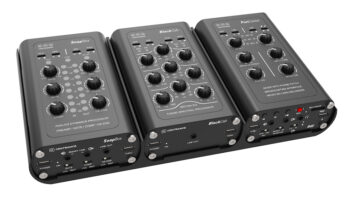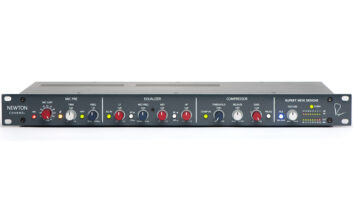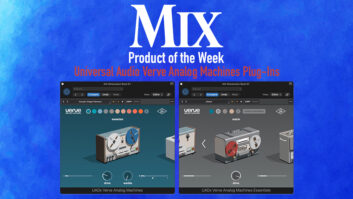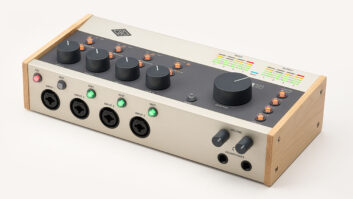

If I were to list my five favorite analog processors of all time, the Universal Audio LA-2A leveling amplifier and 2-610 tube preamp would easily make the list. I often chain them in series to record tracks in my studio. And so I particularly relished the thought of reviewing the company’s new all-tube LA-610 channel strip, which combines a modified channel of the 2-610 with an LA-2A — style optical compressor.
I/O AND CONTROLS
The 2RU LA-610’s rear panel sports separate mic, and line inputs and a line output on balanced XLRs. A high-impedance (instrument DI) input is accessed via an unbalanced ¾-inch phone jack on the front. The compressor section does not have a sidechain input.
The unit’s custom I/O transformers are the exact same ones used in the 2-610. However, the unit’s preamp circuitry departs from a 2-610 channel in significant ways: Two 12AX7 tubes serve the LA-610’s two gain stages, as opposed to one 12AX7 and one 6072 per 2-610 channel. (The 2-610’s 6072 tube output stage has been moved in the LA-610 to serve its compressor’s makeup gain.) The LA-610 also includes a 15dB pad on its front panel, a feature I wish the 2-610 also had, considering the latter’s limited headroom. The LA-610’s preamp is also voiced to have a slightly more prominent high-frequency response than the 2-610.
The LA-610’s preamp section features a five-position rotary switch that selects among line, mic and DI inputs, with the latter two each offering a choice of two different input impedances: 500 ohms or 2 kilohms for mic input, and 47 kilohms or 2.2 megohms for DI. A five-position gain control adjusts the gain of the preamp’s 12AX7 input stage in 5dB increments. As you turn this switch clockwise, negative feedback is reduced and gain increases along with pleasing harmonic distortion. A separate level control serves the 12AX7 output gain stage. Total maximum preamp gain is a respectable 61 dB. Joining the 15dB pad are toggle switches for 48-volt phantom power and polarity reversal.
The preamp section also features independent high- and low-shelving EQ facilities. Two three-way toggle switches let you choose a fixed corner frequency for each band: 70, 100 or 200 Hz for the low EQ; and 4.5, 7 or 10 kHz for the highs. Boost or cut (0/1.5/3/4.5/6/9 dB) is available for each band via switched rotary controls.
COPYCAT COMPRESSOR
The compressor uses the exact same T4 electro-optical cell as the LA-2A, which is notable because the T4 produces the vintage compressor’s fabled and unique compression curve, and attack and release times. One 12AX7 and one 6AQ5 tube serve the sidechain circuit, which includes the T4 module.
The compressor’s operation is simple. Turning up the Peak Reduction rotary control increases compression. A Gain control provides up to 20 dB of makeup gain, courtesy of a 6072 tube. A three-way switch selects among three modes: compression (roughly 2:1 to 3:1 ratio, program-dependent), limit (infinity:1 ratio) or compressor bypass. Setting another three-way rotary switch determines what the LA-610’s small VU meter displays: output level for the unit’s preamp or compressor or amount of gain reduction.
TO THE TEST
I set up an A/B test recording male vocals with a Lawson L251 in omni mode through the LA-610 and then through my 2-610 and LA-2A chained in series. I used roughly the same amount of preamp gain, gain reduction and compressor makeup gain for both signal paths. The LA-610 produced more pronounced highs, detailed transients and leaner, more open mids, as compared to the 2-610/LA-2A combo. The LA-610’s compression characteristics definitely sounded like those of the LA-2A, yielding ultratransparent and natural-sounding control over dynamics, even with 10 dB of gain reduction (per VU meter ballistics). Both paths sounded awesome, with the LA-610 being more modern, sparkly and precise, and the 2-610/LA-2A combo sounding full, dark and chocolaty with understated highs. Despite their spectral differences, both signal paths lent that wonderful tube richness that fans of Universal Audio gear adore.
Next, I used the LA-610 to record an electric guitar using a Roland Micro Cube amp miked with a Royer R-122 ribbon mic. Cutting frequencies above 10 kHz by 3 dB using the LA-610’s flattering EQ and setting the compressor section to Compress mode, I found the results were warm yet present. Fantastic!
Patching an electric bass guitar into the LA-610’s hi-Z input, I got great results once again. Setting the unit’s preamp gain to +10 for grit, cutting the EQ drastically above 4.5 kHz and boosting below 70 Hz, and placing the compressor section in Limit mode, the results were positively thunderous.
CONCLUSION
Owners of 2-610 and LA-2A, have no fear: The LA-610 does not make your treasured investments obsolete. While the LA-610 incorporates many of the flattering sonic attributes of its predecessors, it has its own uniquely beautiful voice. And don’t let the low price ($1,749) fool you — this box belongs in a rack beside the priciest gear. Universal Audio has produced another winner!
Universal Audio, 831/466-3737, www.uaudio.com.
Mix contributing editor Michael Cooper is the owner of Michael Cooper Recording, located in beautiful Sisters, Ore.

Click here to download PDFs of the LA-610’s product manual, recall sheet and other documents.
For a full list of features and specs,click here.







